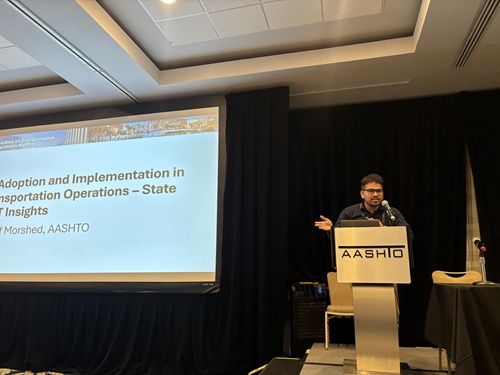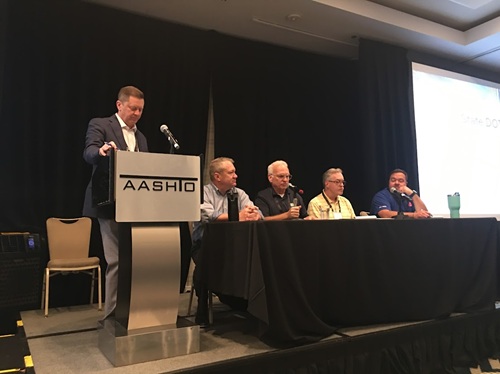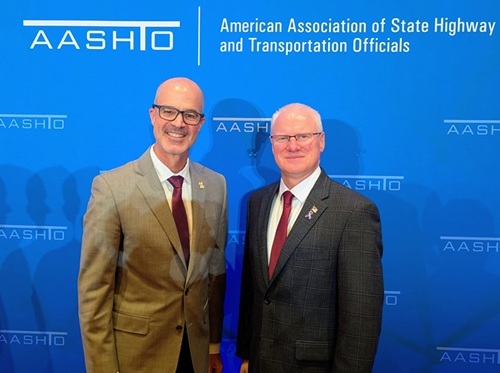The American Association of State Highway and Transportation Officials recently detailed the results of a national survey that examined how states view the potential uses of artificial intelligence or AI in the transportation operations sector.
[Above photo by AASHTO]
Conducted by the AASHTO Committee on Transportation System Operations or CTSO, the survey incorporated responses from 50-plus AASHTO members across the Northeast, South, Midwest, and West and outlined both the potential benefits and challenges AI offers.
“While AI is kind of the ‘new kid of the block,’ we all believe there is a lot of potential with AI – particularly in areas such as traffic signal optimization, infrastructure maintenance, and safety analysis,” explained Scott Marler, director of the Iowa Department of Transportation and chair of AASHTO’s CTSO, during a special AI panel discussion on July 31 at the annual CTSO meeting in Annapolis, MD.
“These types of applications are what we talk about in state DOTs when it comes to AI,” Marler said. “While we must unpack all of that – because there are a lot of challenges along the way – the benefits of AI can be substantial, especially due to operational efficiencies.”

Ahnaf Morshed, AASHTO’s program manager for transportation systems management and operations or TSMO, outlined the survey’s findings ahead of that AI panel discussion – noting that southern state DOTs are currently the leaders in AI deployment and planning.
Based on survey responses, Morshed said the most critical areas where AI can play a role for state DOTs are traffic management and optimization (77.3 percent), data analysis (74.7 percent), and safety/incident detection (73.7 percent).
Concurrently, the biggest challenges and/or risks for state DOTs associated with AI are data quality and availability (76 percent), security (69.3 percent), and reliability (61.3 percent). Lack of a skilled workforce (56 percent) and implementation costs (47 percent) also hinder AI deployment progress, the survey found.
A panel discussion involving four state DOT leaders followed the survey overview, outlining their specific agency’s perspective on the potential benefits and risks the use of AI brings to the transportation sector.

“We want to remove redundant work, remove inefficiencies, and analyze infrastructure data better,” explained Fred Heery, state TSMO program engineer for the Florida Department of Transportation. “We view this as another tool to help us with the everyday challenges we face now and in the future.”
Yet Heery stressed that his agency also drafted a clear policy directive to ensure all AI initiatives were routed through Florida DOT’s cybersecurity division to minimize risk.
The Georgia Department of Transportation engaged a similar policy directive as part of its AI strategy as well.
“Our policy statement on AI is all about establishing ‘here’s where we stand; here is what matters.’ It incorporates very common-sense statements on data governance and risk; creating a framework for contemplating and evaluating new AI projects,” explained John Hibbard, deputy chief engineer for Georgia DOT.
Hibbard noted that his agency’s policy aims to “put a practical face” on the use of AI tools. “[Those tools] offer an opportunity, for example, to take a 600-page SOP [standard operating practice] that is not well organized and extract key information from it – that is a great thing,” he said.
While Jeffrey Van Horn, chief of traffic operations and management for Delaware Department of Transportation, noted that many fear AI will be used to eliminate jobs, he believes it will instead allow state DOT workforces to become more productive.
“When you look at AI on my level, it offers an opportunity to automate many things – to make things less cumbersome and more efficient,” he explained. “So, right now, we’re getting ideas from our ‘boots on the ground’ on the front lines – what can we do with already available AI tools to make things easier and more standardized in our day-to-day operations? We’re trying to get a clear view of those goals and the potential barriers to those goals.”
“Our approach is a continuous AI engagement process; that will help us unlock the workforce potential of AI and where our workforce needs training,” noted Darran Anderson, director of strategy and innovation for the Texas Department of Transportation. “But a fundamental requirement for our AI implementation is that humans make the final decisions.”
Yet he emphasized that the opportunities being afforded by AI are truly significant.
“For example, in [the city of] Austin, we used AI to look at all [traffic] cameras simultaneously. That helped cut our [crash] response time by five to 11 minutes and significantly reduce secondary crashes,” he pointed out. “We’re now about to distribute that system statewide.”
Currently, TxDOT is examining an AI-based system that purportedly can analyze years of roadway crash data to the point where – based on specific road conditions – it can provide a 20-minute “heads up” to potential crash situations.
“I’m not sure if we will really see something like that, but that shows you where you can go with AI – what the next ‘big picture’ move might be,” Anderson said.
 Top Stories
Top Stories
New AASHTO Leadership Elected at 2025 Annual Meeting
November 21, 2025 Top Stories
Top Stories
